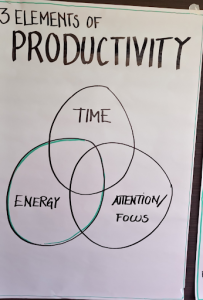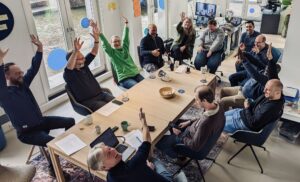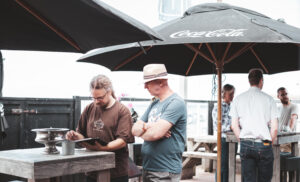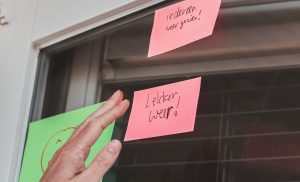May 17, 2022 the Mini XPDay, a one-day conference for and by the Agile community, could finally be held physically again! TrailBlazer Ruud Rietveld did not let this one pass and traveled to neighboring Belgium to get inspired and meet peers. In this article he shares his experiences.
The Mini XPDay is a one-day conference with a program consisting of the highest rated sessions from the previous two-day XPDays conference. The previous XPDays were online, and this mini XPDay was…. physical! That alone was a selling point for me. Also, the program was very interesting (of course, because they were the highest rated sessions). And, perhaps most importantly, there were quite a few colleagues there who I knew and hadn’t seen since Covid. I quickly ordered my tickets and, given the travel time, also booked an overnight stay in advance and reserved a spot in the pre-conference dinner.
The arrival
After the long ride from my assignment and moving into my hotel room, the conference began on the terrace in the sunshine with the meeting of old and new acquaintances. It was a fine reunion. The hotel also served 0.0 Leffe Blond, so that was a very nice way to relax for a while. Dinner was very pleasant, we caught up with each other and one of the organizers had brought along his curious daughter, which gave rise to quite a different kind of conversation. After dinner I went to bed early as the next day’s conference would be strenuous enough.
The Balanced Product Owner
A very interesting session by Robert van Lieshout. First we made a backlog of a fictitious product to be built. Despite the assignment to include backlog items from ‘Sprint 22’, it turned out that 95% of the backlog items were mainly about creating new functionality. The other quadrants of the presented model remained largely empty: Functional Maintenance, Facilitative Creating and Facilitative Maintenance.
You can determine for each Product Backlog Item which quadrant it falls into. Is the item Enabling or Functional? And is it Creating or Maintaining? If you have qualified your backlog in this way, you can make graphs of it to visualize the relations (also as a trend) and start the discussion with the Developers and with the Product Owner. Is this picture correct and is it okay like this or are we missing something? Of course in Sprint 1 you don’t have any ‘Maintenance’ PBIs in your backlog yet, but from Sprint 2 onwards you have a Product and you will have to start doing Maintenance as well.
What made this session even more interesting was the set of templates you can use to better describe different types of Backlog Items. For User Stories (which actually only occur in 1 quadrant) we know the templates, but for Spikes? For Technical Debt? And for Architectural Runway items? Each one could benefit from its own template.
Finally, as icing on the cake, I received a tip from a fellow participant to look into David Evans’ more generic template. This turns out to be an ‘oldie’, good thing I’m discovering it now! I will definitely experiment with this on my teams.
How to find your Energy
The next session was led by Per Beining. Per started the session in his own energetic way and asked some stimulating questions to make us aware of what facilitation and content do to your energy. I also learned that productivity depends (according to author Chris Bailey) on three components: Time Management, Attention Management, and Energy Management.

De rest van de sessie zijn we vooral bezig geweest met hoe je je energie managet voor jezelf en hoe je inzicht krijgt in je patronen (wanneer heb je ‘doe’-energie en wanneer ‘denk’-energie?). Ook ging Per in op activiteiten en personen die energiegevers en energieslurpers zijn. Energiegevers worden bij een overdosis energieslurpers (ken je het fenomeen binge-watchen?). Al met al een interessante sessie, die me zeker kan helpen mijn energie beter te gebruiken.
The rest of the session, we were mainly concerned with how to manage your energy for yourself and how to gain insight into your patterns (when do you have ‘do’ energy and when ‘think’ energy?). Per also discussed activities and persons that are energy givers and energy guzzlers. Energy givers become energy guzzlers when overdosed (do you know the phenomenon of binge-watching?). All in all, an interesting session that can definitely help me use my energy better.
When working harder does not solve the problem anymore
A session by Jan de Baere. It was mainly a presentation, unfortunately little interaction. The subject was interesting though. What Jan actually did was explain the concept of Kanban without using the word Kanban, and with a little twist that for me really was the added value.
The story was about a company that was getting little results from the projects it had running. There were too many projects going on at once, which meant that the teams involved in the projects (usually several teams per project) were often waiting on each other. This was because the projects were picked up to ensure that each team was fully engaged, rather than ensuring that projects were completed as quickly as possible (Kanban principle: Focus on Flow). The nice twist for me came on the concept of Limit your Work-In-Progress: the use of team tokens that represent the capacity of a team. When a team is involved in a project, they hand in a number of tokens and only get them back when the project is fully completed (for the team). This is how you limit work-in-progress for a team. Another interesting outcome for me was the website https://traffic-simulation.de/, which I can use when I use the highway metaphor to explain capacity and overload.
The Happy Imposter
This session by Remi-Armand Collaris and Karen de Boecke (shout out to Karen because she was a last-minute substitute and did a fantastic job!) was about the so-called Imposter Syndrome (which I will call ‘Imposterism’ from now on; it is not a syndrome or disease). Imposterism is something we all have from time to time: the feeling that you are not contributing as much as others and that those others might find out. We started working with a Buddha exercise on obsessions like, “I have to know a lot about a subject before I can talk about it.” The person with the obsession started to delve into the obsession, with the help of the Buddha. The Buddha worked in two rounds, and the first round the Buddha was allowed to ask only 1 question. “Tell me, what is GOOD about <obsession>?”, and in response to the answers do nothing but listen silently with compassion, or repeat that same question. For round two the same thing, but asking (you can feel it coming) “Tell me, what is MISCELLANEOUS with <obsession>?”. By working only with that question, we still went amazingly deep in a short amount of time. I think it would have taken longer with coaching questions. Interesting session!
Conclusion
Overall, a great day with a good payoff for me. It was also fantastic weather so that helped, and I met some really nice people who are all working to make the working world both more fun and more productive. XPDays continues to be highly recommended in the field of Agile Conferences in the Benelux!





